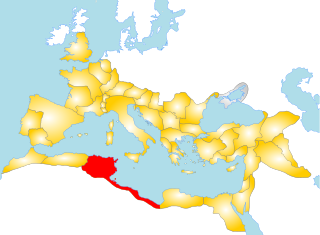
Buslacena was a Roman town and the seat of an ancient Christian bishopric in the Roman province of Africa Proconsularis.

Buslacena was a Roman town and the seat of an ancient Christian bishopric in the Roman province of Africa Proconsularis.
We know of only one bishop of the town, Felix, who attended the Council of Carthage (256) to discuss the issue of the Lapsi. [1] The bishopric survives to day as a titular see of the Roman Catholic Church with only one modern bishop, Alfredo Victor Petit Vergel. [2] [3]
Parthenia was a Roman–Berber town in the former Roman province of Mauretania Sitifensis, the easternmost part of ancient Mauretania. It was located in what is now northern Algeria.

Djelfa is the capital city of Djelfa Province, Algeria and the site of ancient city and former bishopric Fallaba, which remains a Latin catholic titular see.

The Diocese of Tubia is a suppressed and titular see in the province of Mauritania Caesariensis of the Roman Catholic Church. Tubia was a city in North Africa during the Roman, Byzantine and Vandal empires that is identifiable with the ruins of Henchir-Toubia.

Absa Salla was a Roman and Byzantine-era town in the Roman province of Africa proconsularis. It was also the seat of a titular see of the Roman Catholic Church. with the same name. The location of the town remains unknown but is known to have existed for certain between 300 and 650AD.
Bulnensis, also known as Bure, is a titular episcopal see of the Roman Catholic Church ascribed to the ecclesiastical province of Africa Proconsularis, as a suffragan of the Archdiocese of Carthage.
Taborenta, Mauretania Caesariensis was a Berber civitas (town) and bishopric in Roman North Africa. It disappeared during the 7th century, and is assumed to be near Saida in modern Algeria. It was nominally restored in 1933 as a titular see.

Cissita was a town and bishopric of Roman North Africa, which only remains as a Catholic titular see.
Canapium was a Roman–Berber town in the province of Africa Proconsolare. Its stone ruins are located near Henchir-El-Casbath, in the region of Mornag, Tunisia.

Cubda was an ancient city in Tunisia. It is a titular bishopric of the Roman Catholic Church.
Bir Mcherga is a town and commune in the Zaghouan Governorate, Tunisia in the northwest of Tunisia, the site of former Roman North African city and bishopric Giufi, which only remains as Latin Catholic titular see.
Paria in Proconsulari is an Ancient town and former bishopric in Roman Africa and now a Latin titular see of the Roman Catholic Church.
Botriana is a locality and archaeological site in Tunisia

Enera was a Roman–Berber civitas (town) in the province of Numidia. It is believed to have been located in modern Algeria. The town was also a former Roman Catholic diocese.
Henchir-Khachoum is a locality and series of archaeological sites in Sidi Bouzid Governorate modern Tunisia. The ruins are strewn along a tributary of the Oued El Hatech river east of Sbeitla. During the Roman Empire there was a Roman town of the Roman province of Africa Proconsularis, called Muzuca, one of two North African towns to bare that name.

Mattiana was a Roman-Berber civitas in the province of Africa Proconsularis. The locale existed during late antiquity, and was situated in northern Tunisia.

Zarna was a Roman town of the Roman Empire during late antiquity. An exact location for the town has been lost to history, although that it was in the Roman province of Africa Proconsolare means it must have been in northern Tunisia.

Ksour-El-Khaoua is a locality in southern Tunisia, North Africa. During the Roman Empire the town was a civitas (town) in the Roman province of Byzacena. and the seat of an ancient Christian bishopric.

Masuccaba an ancient Roman town in the Roman province of Mauretania Caesariensis.

The Diocese of Subbar is a suppressed and titular see of the Roman Catholic Church.

Madarsuma was a Roman town of the Roman province of Byzacena during the Roman Empire and into late antiquity. The city now lost to history remains only as a suppressed and titular see of the Catholic Church.